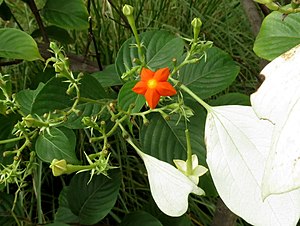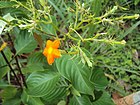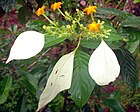Note: This is a project under development. The articles on this wiki are just being initiated and broadly incomplete. You can Help creating new pages.
Difference between revisions of "Mussaenda frondosa"
| (4 intermediate revisions by 2 users not shown) | |||
| Line 1: | Line 1: | ||
| − | + | [[File:Mussaenda frondosa 011.JPG|thumb|right|'''Mussaenda frondosa''']] | |
| + | '''Mussaenda frondosa''' is the wild mussaenda or dhobi tree. It is a shrub that grows upto 1.5–2 m tall. Like all other Mussaenda species, they have a large prominent white petaloid sepal in their flowers. | ||
==Uses== | ==Uses== | ||
| − | {{Uses|}}, {{Uses|}}, {{Uses|}}, {{Uses|}}, {{Uses|}}, {{Uses|}}, {{Uses| | + | {{Uses|Jaundice}}, {{Uses|Cancer}}, {{Uses|Leprosy}}, {{Uses|Asthma}}, {{Uses|Hyperacidity}}, {{Uses|Fever}}, {{Uses|Cough}}. |
==Parts Used== | ==Parts Used== | ||
| − | {{Parts Used|}}, {{Parts Used| | + | {{Parts Used|Flower}}, {{Parts Used|Leaves}}. |
==Chemical Composition== | ==Chemical Composition== | ||
| − | <ref name=" | + | Iridoids, flavonoids and triterpenes are the common chemical ingredients distributed in Mussaenda species etc.<ref name="Chemical Composition"/> |
==Common names== | ==Common names== | ||
| − | {{Common names | + | {{Common names|kn=ಬೆಲ್ಲೊಟ್ಟಿ Bellotti|ml=Vellila|sa=Shrivati|ta=Velli-matantai|te=|hi=Bedina|en=Dhobi Tree, Flag bush}} |
==Properties== | ==Properties== | ||
Reference: Dravya - Substance, Rasa - Taste, Guna - Qualities, Veerya - Potency, Vipaka - Post-digesion effect, Karma - Pharmacological activity, Prabhava - Therepeutics. | Reference: Dravya - Substance, Rasa - Taste, Guna - Qualities, Veerya - Potency, Vipaka - Post-digesion effect, Karma - Pharmacological activity, Prabhava - Therepeutics. | ||
===Dravya=== | ===Dravya=== | ||
| + | |||
===Rasa=== | ===Rasa=== | ||
| − | |||
===Guna=== | ===Guna=== | ||
| Line 29: | Line 30: | ||
==Habit== | ==Habit== | ||
| − | {{Habit|}} | + | {{Habit|Herbs}} |
==Identification== | ==Identification== | ||
===Leaf=== | ===Leaf=== | ||
| − | {{Leaf|||}}<ref name="Leaf"/> | + | {{Leaf|Simple|Elliptic leaves|7.5-13.7 long, 4.5-8 cm broad, tip shortly tapering. Base is rounded or tapering into the 2-2.5 cm long stalk. Stipules are twin, lanceshaped.}}<ref name="Leaf"/> |
===Flower=== | ===Flower=== | ||
| − | {{Flower||| | + | {{Flower|Bisexual|Flat-topped clusters|Creamy-yellow elliptic, golden yellow||Actual flowers are 3-4 cm long, tube slender, very hairy. Berries are obovoid, 1-1.3 cm long}} |
| − | |||
| − | |||
| − | |||
===Other features=== | ===Other features=== | ||
| Line 46: | Line 44: | ||
==Where to get the saplings== | ==Where to get the saplings== | ||
| − | |||
==Mode of Propagation== | ==Mode of Propagation== | ||
| − | {{Propagation|}} | + | {{Propagation|Seeds}}. |
==How to plant/cultivate== | ==How to plant/cultivate== | ||
| − | <ref name="How to plant/cultivate"/> | + | A plant of subtropical to tropical areas, it is found at elevations up to 1,200 metres in Nepal.<ref name="How to plant/cultivate"/> |
==Commonly seen growing in areas== | ==Commonly seen growing in areas== | ||
| − | {{Commonly seen| | + | {{Commonly seen|Garden area}}. |
==Photo Gallery== | ==Photo Gallery== | ||
<gallery class="left" caption="" widths="140px" heights="140px"> | <gallery class="left" caption="" widths="140px" heights="140px"> | ||
| − | + | File:Mussaenda frondosa (13913390616).jpg | |
| + | File:Mussaenda frondosa 04.JPG | ||
| + | File:Mussaenda frondosa 06.JPG | ||
| + | File:Mussaenda frondosa 01.JPG | ||
| + | File:വെള്ളിലയുടെ പൂങ്കുല, mussaenda frondosa.JPG | ||
</gallery> | </gallery> | ||
==References== | ==References== | ||
| + | |||
<references> | <references> | ||
| + | <ref name="Chemical Composition">[http://www.ethnoleaflets.com/leaflets/mussaend.htm#:~:text=Iridoids%2C%20flavonoids%20and%20triterpenes%20are,the%20iridoids%20and%20triterpene%20saponins.&text=Mussaendosides%20M%202%20and%20N%203%20are%20the%20saponins%20from%20M. Chemical composition]</ref> | ||
| − | <ref name=" | + | <ref name="Leaf">[https://www.flowersofindia.net/catalog/slides/Dhobi%20Tree.html Morphology]</ref> |
| − | |||
| − | |||
| − | <ref name="How to plant/cultivate">[ | + | <ref name="How to plant/cultivate">[http://tropical.theferns.info/viewtropical.php?id=Mussaenda+frondosa Cultivation Details]</ref> |
| − | |||
</references> | </references> | ||
==External Links== | ==External Links== | ||
| − | * [ ] | + | * [http://www.theplantlist.org/tpl1.1/record/kew-130401 Mussaenda frondosa on theplantlist.org] |
| − | + | ||
| − | + | ||
[[Category:Herbs]] | [[Category:Herbs]] | ||
| − | [[Category: | + | [[Category:Rubiaceae]] |
Latest revision as of 12:20, 25 June 2020
Mussaenda frondosa is the wild mussaenda or dhobi tree. It is a shrub that grows upto 1.5–2 m tall. Like all other Mussaenda species, they have a large prominent white petaloid sepal in their flowers.
Contents
- 1 Uses
- 2 Parts Used
- 3 Chemical Composition
- 4 Common names
- 5 Properties
- 6 Habit
- 7 Identification
- 8 List of Ayurvedic medicine in which the herb is used
- 9 Where to get the saplings
- 10 Mode of Propagation
- 11 How to plant/cultivate
- 12 Commonly seen growing in areas
- 13 Photo Gallery
- 14 References
- 15 External Links
Uses
Jaundice, Cancer, Leprosy, Asthma, Hyperacidity, Fever, Cough.
Parts Used
Chemical Composition
Iridoids, flavonoids and triterpenes are the common chemical ingredients distributed in Mussaenda species etc.[1]
Common names
| Language | Common name |
|---|---|
| Kannada | ಬೆಲ್ಲೊಟ್ಟಿ Bellotti |
| Hindi | Bedina |
| Malayalam | Vellila |
| Tamil | Velli-matantai |
| Telugu | |
| Marathi | NA |
| Gujarathi | NA |
| Punjabi | NA |
| Kashmiri | NA |
| Sanskrit | Shrivati |
| English | Dhobi Tree, Flag bush |
Properties
Reference: Dravya - Substance, Rasa - Taste, Guna - Qualities, Veerya - Potency, Vipaka - Post-digesion effect, Karma - Pharmacological activity, Prabhava - Therepeutics.
Dravya
Rasa
Guna
Veerya
Vipaka
Karma
Prabhava
Habit
Identification
Leaf
| Kind | Shape | Feature |
|---|---|---|
| Simple | Elliptic leaves | 7.5-13.7 long, 4.5-8 cm broad, tip shortly tapering. Base is rounded or tapering into the 2-2.5 cm long stalk. Stipules are twin, lanceshaped. |
Flower
| Type | Size | Color and composition | Stamen | More information |
|---|---|---|---|---|
| Bisexual | Flat-topped clusters | Creamy-yellow elliptic, golden yellow | Actual flowers are 3-4 cm long, tube slender, very hairy. Berries are obovoid, 1-1.3 cm long |
Other features
List of Ayurvedic medicine in which the herb is used
Where to get the saplings
Mode of Propagation
How to plant/cultivate
A plant of subtropical to tropical areas, it is found at elevations up to 1,200 metres in Nepal.[3]
Commonly seen growing in areas
Photo Gallery
References
External Links
- Ayurvedic Herbs known to be helpful to treat Jaundice
- Ayurvedic Herbs known to be helpful to treat Cancer
- Ayurvedic Herbs known to be helpful to treat Leprosy
- Ayurvedic Herbs known to be helpful to treat Asthma
- Ayurvedic Herbs known to be helpful to treat Hyperacidity
- Ayurvedic Herbs known to be helpful to treat Fever
- Ayurvedic Herbs known to be helpful to treat Cough
- Herbs with Flower used in medicine
- Herbs with Leaves used in medicine
- Herbs with common name in Kannada
- Herbs with common name in Hindi
- Herbs with common name in Malayalam
- Herbs with common name in Tamil
- Herbs with common name in Sanskrit
- Herbs with common name in English
- Habit - Herbs
- Index of Plants which can be propagated by Seeds
- Herbs that are commonly seen in the region of Garden area
- Herbs
- Rubiaceae





